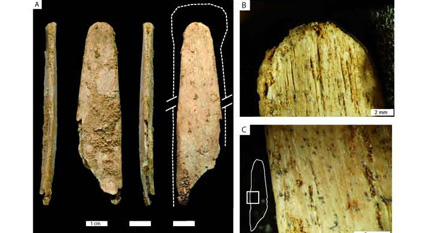Neanderthals Made the First Specialised Bone Tools In Europe
Neanderthals Shaped Animal Bones So That They Could Work Leather
For many thousands of years, modern humans (Homo sapiens) and Neanderthals (Homo neanderthalensis) lived in western Europe, it is not known how much interaction there was between these two species of hominids. Neanderthals, far from being the slow-witted, ape-men of Victorian literature were very well adapted to living in cold climates, skilled tool makers and very capable hunters. In Neanderthal fossil sites dated to near the time when this species became extinct, a few thousand years after the arrival of modern humans in western Europe, tools and other objects have been found that are very similar to those found in contemporaneous fossil sites of modern humans.
Neanderthals
Neanderthals show behaviours similar to those associated with modern humans and have similar fine tools, such as small stone blades and bone implements.
Evidence of Neanderthals Being Skilled Leather Workers

Human and Neanderthal genetic research. Evidence suggests that Neanderthals were skilled leather workers and therefore able to make clothes.
The picture (above) shows two CollectA Neanderthal models, to view these replicas (whilst stocks last): CollectA Prehistoric Life Figures.
Sophisticated Behaviours
It had been thought that much of these sophisticated behaviours inferred from artefacts found at Neanderthal fossil sites, had been developed as a result of contact between Neanderthals and our own species. Modern humans arrived in western Europe around 40,000 years ago and it is after this date that such sophisticated tools turn up in Neanderthal dig sites.
In a new study, published in the academic journal the Proceedings of the National Academy of Sciences (USA), a team of researchers report the discovery of specialised bone tools previously only associated with Homo sapiens that date from a Neanderthal site that is at least 50,000 years old – before (so it is thought), the arrival of modern man in western Europe. This suggests that Neanderthals did not learn sophisticated tool making skills from us, they may have developed such technologies themselves.
Tools Made from Animal Bones
Co-author of the study, Zenobia Jacobs of the University of Wollongong (New South Wales, Australia) stated that the tools were polishing tools made from animal bones. These “lissoir” tools were used to work the hides of animals and the Neanderthal bone tools predate similar discoveries made in western Europe by about 10,000 years.
The tools were found in south-western France and the University of Wollongong has been engaged in a major project to assess Neanderthal and early human European cultures. This new study, forms just part of the University’s research.
This discovery implies that the two hominid species either learned how to work animal skins separately, or modern humans may have picked up the skills required from the Neanderthals. Dr. Jacobs suggests that it may have been the later, with modern humans learning from Neanderthals.
The Bone Tools Discovered at the Site in South-western France
Picture credit: Proceedings of the National Academy of Sciences
Picture A shows a bone tool, the dotted line shows the original shape of the bone before it was sculpted and shaped into a tool for use in leather work. The close up images of the bones show evidence of wear as seen in modern lissoir tools used today in the fashion industry.
Used to Prepare Animal Hides
Dr Jacobs said the tools were used to smooth and burnish deer hides and make them water resistant. They were identically shaped to plastic lissoir tools used today by top fashion houses. The specialised bone tools have microscopic wear patterns preserved on them, the wear is consistent with the use of lissoir in modern times to obtain supple, lustrous, and more impermeable hides.
The discovery contradicts theories that Neanderthals were “cognitively challenged dead-ends” who had been supplanted by Homo sapiens because they were stupid, Dr Jacobs said. Neanderthals have also been found to have had the genetic and anatomical features necessary for speech.
Dr Jacobs added:
“I don’t think they were stupid at all. They were probably quite capable of inventing all sorts of things that modern humans would like to claim as their own.”
Smart Neanderthals
Dr Jacobs commented that it had long been believed that humans began behaving in a modern fashion, characterised by the use of symbols, when they reached Europe.
“Now it’s generally accepted that we probably had those abilities over the last 100 to 150 thousand years,” the doctor stated.
While it is not clear why Homo sapiens displaced the Neanderthals, Dr Jacobs said there had been plenty of interbreeding and most people now had between 2.5 per cent and 4 per cent of Neanderthal DNA in their genes.
She quipped:
“Maybe those leather workers are the ones with more Neanderthal genes.”
As these finds clearly predate the oldest known age for the use of similar objects in Europe by anatomically modern humans, they could also be evidence for cultural diffusion from Neanderthals to modern humans.


